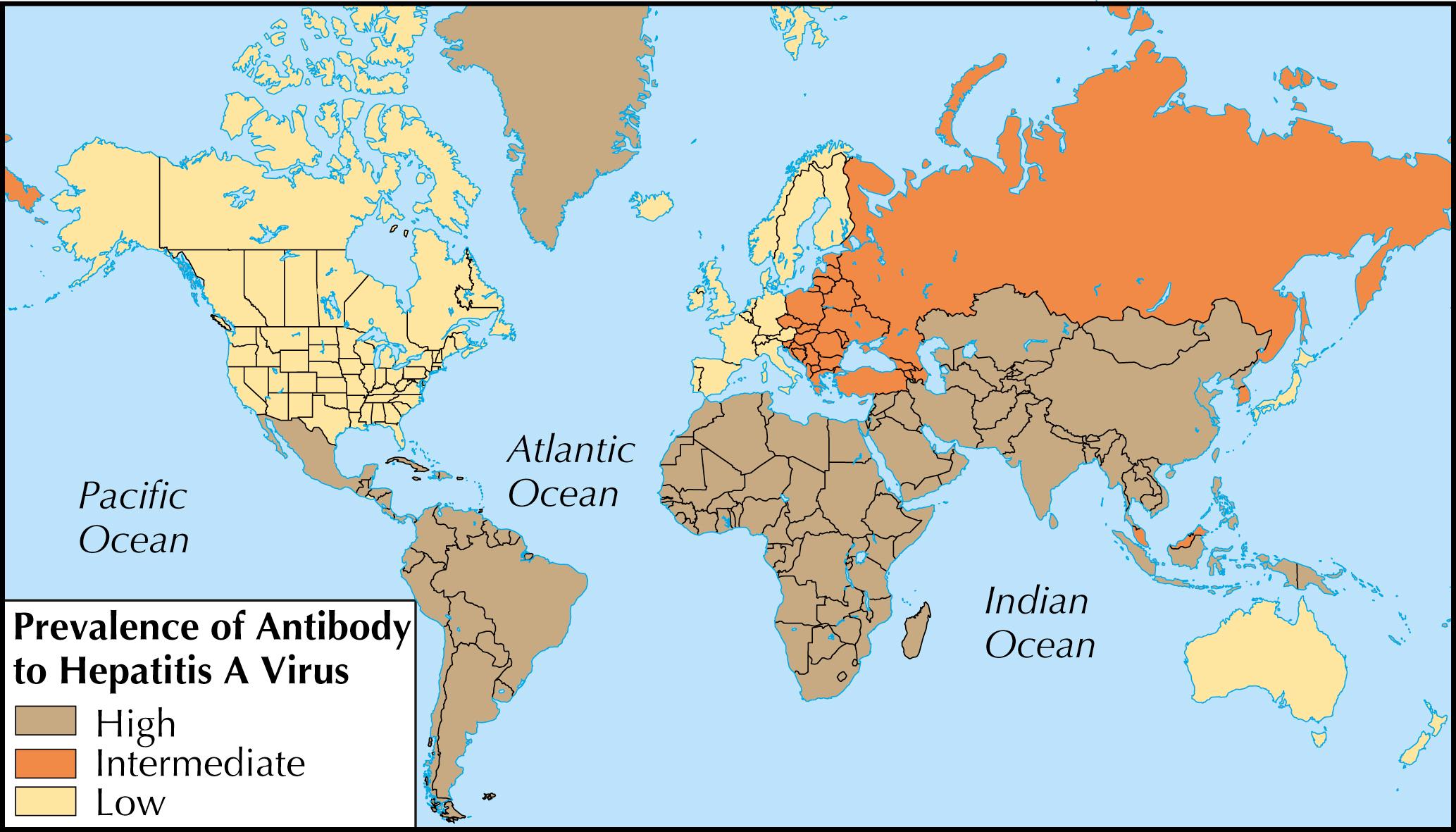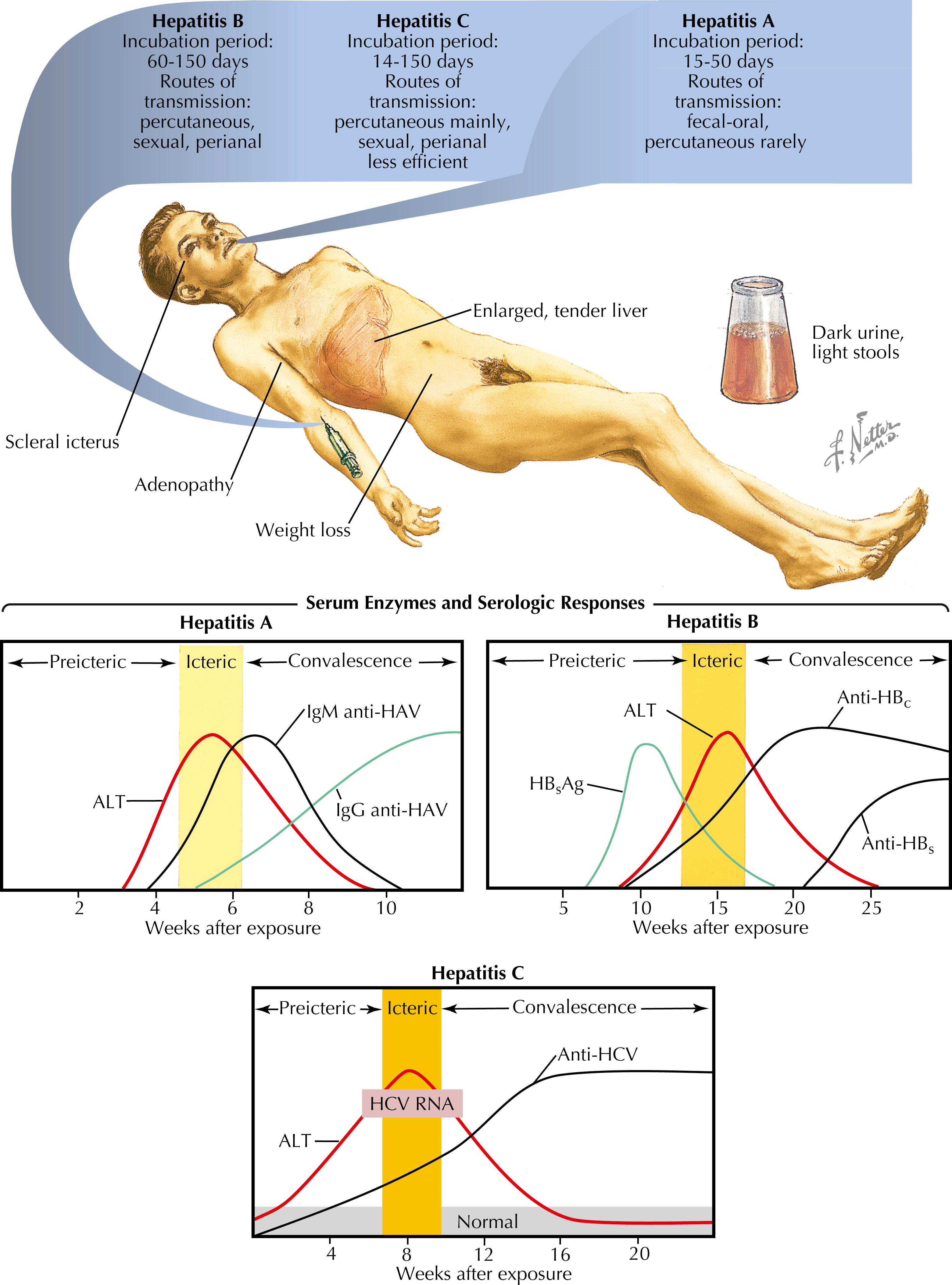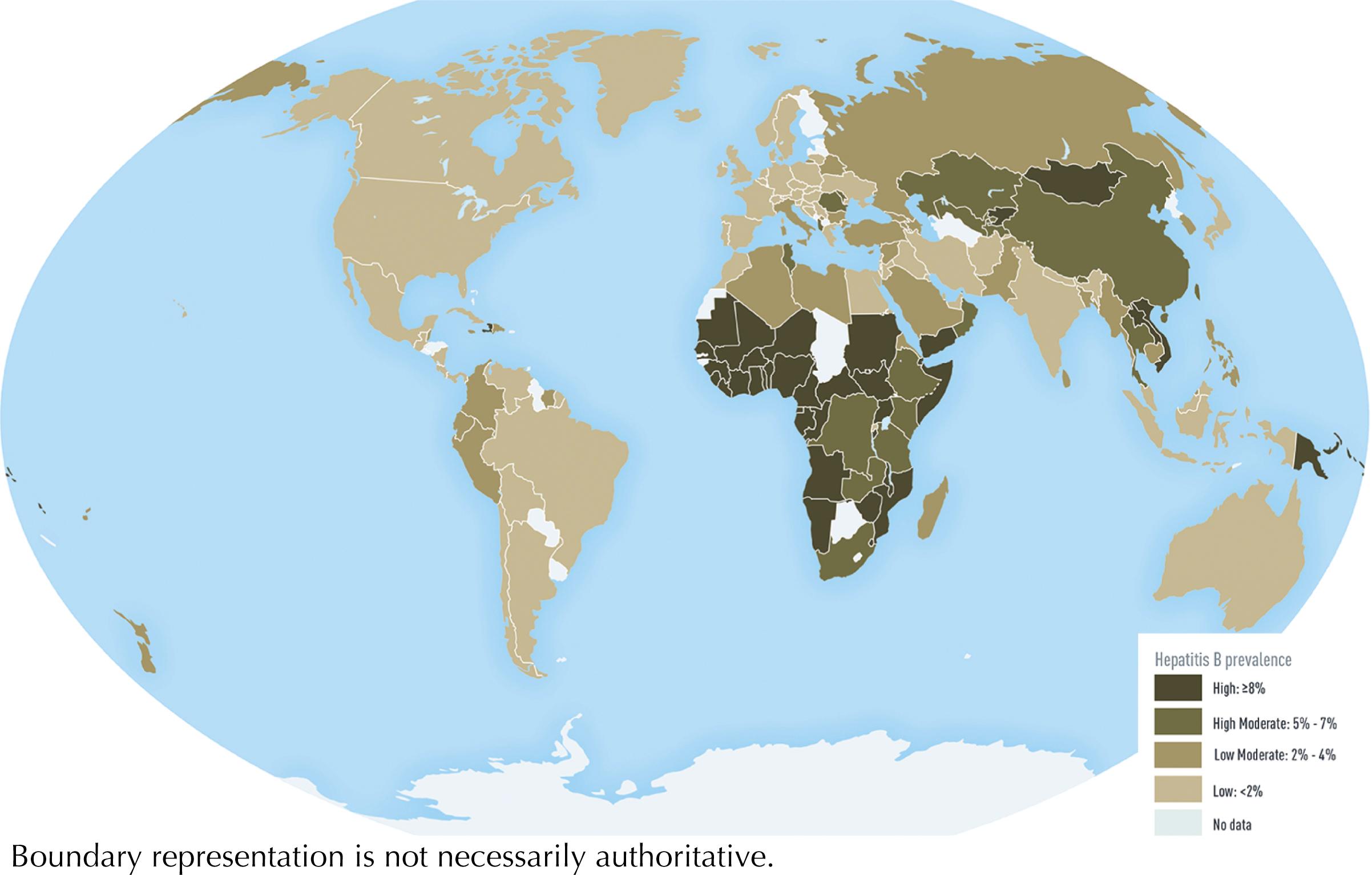Physical Address
304 North Cardinal St.
Dorchester Center, MA 02124
The authors acknowledge the work of Michael James Babineaux and Miriam J. Alter on this chapter in the previous edition.
Viral hepatitis is caused by infection with five distinctly different human viruses that cannot be distinguished from one another without serologic testing ( Table 68.1 ). Hepatitis A virus (HAV), hepatitis B virus (HBV), hepatitis C virus (HCV), hepatitis delta virus (HDV), and hepatitis E virus (HEV) have distinct differences in their epidemiology, physical structure, pathobiology, and prognosis, yet all involve the liver as the primary target organ. The severity of liver disease that accompanies acute infection with these viruses generally distinguishes them from cytomegalovirus and Epstein-Barr virus, whose primary target is not the liver and which typically cause much milder liver dysfunction during primary infections. The major burden of disease caused by hepatitis virus infections stems from chronic liver damage with progression to cirrhosis and hepatocellular carcinoma (HCC), which occurs in individuals who develop persistent infection. Development of persistent infection is highly dependent on the infecting virus and host factors such as age, co-infections, comorbidities, and underlying immune status. In areas of the world with the highest incidence of HCC (Southeast Asia, sub-Saharan Africa), most cases are attributed to HBV infection. In areas of the world where an increase in the incidence of HCC (and cirrhosis) has been more recent (United States, Western Europe, Japan, Australia), the leading cause is HCV infection.
| HAV | HBV | HCV | HDV | HEV | |
|---|---|---|---|---|---|
| Incubation period | 15–50 days (average 28 days) | 60–150 days (average 90 days) | 14–182 days (average range 14–84 days) | Similar to HBV | 15–60 days (average 40 days) |
| Source of virus | Feces | Blood (highest virus concentration), semen, other body fluids | Blood (highest virus concentration), semen, other body fluids | Blood (highest virus concentration), semen, other body fluids | Feces |
| Routes of transmission | Fecal-oral: close person-to-person contact, contaminated food and water, rarely through contaminated blood transfusion | Percutaneous, mucosal, or nonintact skin exposure: birth to an infected mother, sexual contact, sharing contaminated needles, syringes, or other injection drug equipment, needlesticks or other sharp instrument injuries, unscreened blood transfusions or organ transplants, dialysis, shared use of personal items such as razors or toothbrushes of an infected person | Similar to HBV | Similar to HBV | Fecal-oral: through contaminated water, contact with zoonotic source (e.g., pigs) |
| Potential for persistent or chronic infection | No | Yes: 90% of infants infected at birth, 25%–50% of children infected at ages 1–5 years, 5% of people infected as adults | Yes: Chronic infection develops in over 50% of newly infected people | Yes | No |
| Vaccine available | Yes | Yes | No | No: prevent HDV co-infection by preventing HBV infection with HBV vaccine. | No |
A hospital nurse sustains a needlestick injury with a contaminated needle to her left thumb, through her protective glove, while caring for a seriously ill patient during the night shift. The patient is an intravenous drug user with recurrent endocarditis. She washes the wound vigorously with soap and water as soon as possible, and goes to the hospital’s employee health clinic (EHC) in the morning when she gets off duty, before going home. The nurse is 29 years old and reports herself in good health, with no acute illness or chronic health conditions. She is single, has a boyfriend, and lives alone at present. She went on a volunteer medical mission to Indonesia last summer for a month. Her vaccine records show that she has received tetanus-diphtheria-acellular-pertussis vaccine, measles-mumps-rubella vaccine, varicella vaccine, poliovirus booster, hepatitis B vaccine (HBsAb response ≥10 mIU/mL), hepatitis A vaccine, typhoid vaccine, and the annual flu vaccine.
In the EHC, the needlestick injury is examined, an incident report form completed, and her blood is drawn for standard screening tests for bloodborne pathogens (BBPs): HBV, HCV, and human immunodeficiency virus (HIV). Three days after the incident, the nurse receives a call back from the EHC: her test results show that she is HCV antibody positive and HCV RNA positive. This is a change from when she was last tested 3 years ago, when her HCV antibody test was nonreactive. The current test results are compatible with active HCV infection, and she is referred to her primary-care clinician for further medical evaluation, counseling, specialty consultation, and treatment. Although the nurse had a needlestick injury associated with a high-risk patient in this reported incident, given the HCV incubation period range of 14 to 182 days it is most likely that her active HCV infection is the result of an earlier exposure. The majority of acute HCV cases are asymptomatic or have unrecognized mild symptoms, and the presence of chronic HCV infection is often discovered during later screening.
A 34-year-old homeless man is referred to the primary-care clinic for evaluation by the city’s outreach team. Considering his history of IV drug abuse for several years, he is screened and found positive for HIV. In view of his homeless state and the risk of being lost to follow-up before appropriate management can be started, he is admitted and the recommended workup for a newly diagnosed HIV patient initiated. He gives a history of becoming homeless after losing his job in the construction industry 3 years ago. He received the hepatitis B vaccine upon induction into the army when he was 18 years old. His lab results show an unremarkable complete blood count and chemistry profile including liver function tests. Serology tests confirm that he is HIV-1 reactive by immunoassay, hepatitis B surface antibody positive, hepatitis B core antibody negative, and hepatitis C antibody positive. The patient’s CD4+ T-cell count is 1100 per mm 3 ; his plasma HIV RNA and hepatitis C RNA are pending. Although he relapsed after a prior IDU treatment attempt, he realizes that his health is now on a downward spiral and desires treatment for his drug dependence and newly detected HIV and hepatitis C infections.
Risk factors associated with homelessness include unsafe injectable drug use, HIV infection, HCV infection, and incarceration. Community outbreaks of hepatitis A also have been associated with the poor sanitary conditions in homeless encampments. The US homeless population is highly impacted by HCV, with prevalence estimates ranging from 20 to >50%. Effective drug treatment regimens to manage HIV and hepatitis C infections are available but considering possible drug-drug interactions, a decision may be made to treat the two infections sequentially in this patient. Management and follow-up of this patient will be challenging: homeless people lead unstable lives, move around frequently, may not have good access to healthcare, and often have food and shelter priorities that take precedence over access and adherence to healthcare recommendations.
According to the World Health Organization (WHO), hepatitis A caused approximately 7134 deaths in 2016, which accounted for 0.5% of mortality due to viral hepatitis. Transmission being primarily fecal-oral, risk factors are lack of safe water and poor sanitation and hygiene (such as dirty hands). Worldwide, the endemicity of HAV infection differs markedly among and within countries depending on the age groups in which the majority of transmission occurs. In areas with a high endemic pattern of infection, represented by low-income countries in parts of Africa, Asia, and Central and South America, most persons are infected as young children, and essentially the entire population becomes infected and immune before reaching adolescence. At the other end of the spectrum are the higher-income countries in most areas of North America and Western Europe, in which the endemicity of HAV infection is low. Relatively fewer children are infected, and disease often occurs in the context of communitywide outbreaks, as well as in defined risk groups such as men who have sex with men (MSM), injection drug users (IDUs), and travelers returning from areas with a high or intermediate endemicity of infection ( Fig. 68.1 ).

HAV replicates in the liver, is excreted in bile, and is shed in stool. Peak infectivity occurs during the 2-week period before onset of jaundice or elevation of liver enzymes, when concentration of the virus in stool is highest. The concentration of the virus in stool declines after jaundice appears. Children can shed HAV for longer periods than adults, with shedding lasting up to 10 weeks after onset of clinical illness; infants infected as neonates in one nosocomial outbreak shed HAV for up to 6 months, but lifelong shedding of the virus does not occur.
In the United States, person-to-person transmission through the fecal-oral route is the primary means of HAV transmission. Transmission occurs most frequently among close contacts, especially in households, extended family settings, daycare facilities, correctional facilities, and unsheltered populations. Common-source outbreaks and sporadic cases can occur from exposure to food or water contaminated at the source or by infected food handlers. Outbreaks in the context of floods or other natural disasters (e.g., hurricanes) have not been reported in the United States. On rare occasions, HAV infection has been transmitted by transfusion of blood or blood products collected from donors during the viremic phase of their infection. In the United States and other countries where the hepatitis A vaccine has been incorporated into standard childhood immunization programs, the burden of HAV infections has shifted to older unimmunized age groups who are more likely to be symptomatic (see Chapter 14 ).
HAV, a 27-nm ribonucleic acid (RNA) agent classified as a picornavirus, can produce either asymptomatic or symptomatic infection in humans after an average incubation period of 28 days (range 15 to 50 days). Illness caused by HAV infection typically has an abrupt onset that can include fever, malaise, anorexia, nausea, abdominal discomfort, dark urine, and jaundice. The likelihood of having symptoms with HAV infection is related to age. In children younger than 6 years, 70% of infections are asymptomatic; if illness does occur, it is typically not accompanied by jaundice. Among older children and adults, infection is typically symptomatic, with jaundice occurring in more than 70% of patients. Signs and symptoms typically last less than 2 months, although 10% to 15% of symptomatic persons have prolonged or relapsing disease lasting up to 6 months ( Fig. 68.2 ). However, persistent infections with HAV are not well documented and may never occur. The overall case-fatality ratio among reported cases in the United States is approximately 0.3% to 0.6% but reaches 1.8% among adults older than 50 years; persons with preexisting chronic liver disease are at increased risk of acute liver failure from HAV infection.

HAV cannot be differentiated from other types of viral hepatitis on the basis of clinical or epidemiologic features alone. Two serologic tests are licensed for the detection of antibodies to HAV: (1) immunoglobulin M antibody to HAV (IgM anti-HAV) and (2) total anti-HAV (i.e., IgM and IgG anti-HAV). Serologic testing to detect IgM anti-HAV is required to confirm a diagnosis of acute HAV. In the majority of persons, serum IgM anti-HAV becomes detectable 5 to 10 days before onset of symptoms and declines to undetectable levels less than 6 months after infection. IgG anti-HAV, which appears early in the course of infection, remains detectable for the person’s lifetime and provides lifelong protection against the disease.
HAV does not cause persistent infection and rarely causes hepatic failure. Supportive care is the mainstay of treatment for HAV infections. Individuals with acute HAV with altered mental status or severe dehydration from nausea and vomiting require hospitalization. Laboratory results revealing increased international normalized ratio (INR) and/or reduced albumin may indicate systemic dysfunction that requires consultation with a hepatologist. If hepatic encephalopathy develops, liver transplantation may be indicated. Patients with minimal symptoms can be managed on an outpatient basis.
Depending on conditions, HAV can be stable in the environment for months. Heating foods at temperatures greater than 185°F (85°C) for 1 minute or disinfecting surfaces with a 1:100 dilution of sodium hypochlorite (i.e., household bleach) in tap water is necessary to inactivate HAV. HAV can be prevented by (1) general measures of good personal hygiene, particularly hand washing, provision of safe drinking water, and proper disposal of sanitary waste; (2) preexposure or postexposure immunization with HAV vaccine; and (3) preexposure or postexposure immunization with immunoglobulin (see Chapter 14 ). In the United States, preexposure administration of HAV vaccine is recommended for all children 1 year of age and older, international travelers, MSM, injection and noninjection illicit drug users, and individuals with chronic liver disease. Inactivated HAV vaccines are safe, highly immunogenic, and well tolerated. Table 68.2 lists the HAV vaccines and schedules approved by the US Food and Drug Administration (FDA). Other HAV vaccine products, including attenuated live vaccines, may be available in other countries.
| Vaccine | Trade Name (Manufacturer) | Age | Dose | Route | Schedule | Booster |
|---|---|---|---|---|---|---|
| Hepatitis A, inactivated | Havrix (GlaxoSmithKline) | 1–18 years | 0.5 mL (720 ELU) | IM | 0, 6–12 months | None |
| ≥19 years | 1.0 mL (1440 ELU) | IM | 0, 6–18 months | None | ||
| Hepatitis A, inactivated | VAQTA (Merck & Co, Inc) | 1–18 years | 0.5 mL (25 U) | IM | 0, 6–18 months | None |
| ≥19 years | 1.0 mL (50 U) | IM | 0, 6–18 months | None | ||
| Hepatitis A+B, combined | Twinrix (GlaxoSmithKline) | ≥18 years | 1.0 mL (720 HAV ELU + 20 μg HBsAg) |
IM | 0, 1, 6 months | None |
Approximately one-third of the global population has been infected with HBV. Around 5% of this population are chronic carriers and a quarter of these carriers develop serious liver diseases such as chronic hepatitis, cirrhosis, and hepatic carcinoma. Globally, hepatitis B prevalence is highest in the WHO Western Pacific Region and the WHO African Region, where 6.2% and 6.1% of the adult population is infected, respectively. In the general US population, the overall age-adjusted prevalence of HBV infection (including persons with chronic infection and those with previous infection) is 4.9%. The estimated prevalence of chronic HBV infection is 0.5%, corrected for the disproportionate contribution of foreign-born persons (particularly Asian/Pacific Islanders) who have emigrated from countries in which HBV is highly endemic. It is estimated that there were 862,000 persons with chronic HBV infection in 2016, and 22,000 new infections in 2017 nationwide.
HBV is a blood-borne and sexually transmitted virus. Transmission from infected mothers to their newborns at the time of birth is the most common source for HBV infection among infants. For adults, the primary sources are sexual (male to female and male to male) and percutaneous (e.g., injection drug use) exposures to blood. For all age groups, unsafe therapeutic injections, unscreened blood transfusions, and long-term nonsexual household contact with chronically infected persons are risks for acquiring HBV infection.
Chronic infection (serum positivity for hepatitis B surface antigen [HBsAg]) is more likely to develop in infants infected at birth (90%) or young children infected at ages 1 to 5 years (25% to 50%), most of whom do not have symptoms. Rates of symptomatic acute disease are higher among older children and adults, who are less likely to develop chronic infection. Prevalence of chronic infection with HBV is high in countries or regions where HBV infections were historically acquired primarily by infants and young children, including countries in South America, Africa, the Middle East, Asia, Southeast Asia, Greenland, the First Nation populations of northern Canada, and Alaskan Native Americans ( Fig. 68.3 ). In those countries or regions where universal childhood hepatitis B immunization programs have been implemented, early-age infections have been virtually eliminated and adults account for the remaining chronic infections (see Chapter 15 ).

HBV is a 42-nm DNA virus classified in the family Hepadnaviridae. HBV infection can produce either asymptomatic or symptomatic infection. The average incubation period is 90 days (range 60 to 150 days) from exposure to onset of jaundice, 60 days (range 40 to 90 days) from exposure to onset of abnormal serum alanine aminotransferase (ALT) levels, and 30 days (range 6 to 60 days) from exposure to detection of HBsAg. The onset of acute disease is usually insidious. Infants, young children, and immunosuppressed adults with newly acquired HBV infection are typically asymptomatic. When present, clinical symptoms and signs might include anorexia, malaise, nausea, vomiting, abdominal pain, and jaundice (see Fig. 68.2 ). Extrahepatic manifestations of disease include skin rashes, arthralgias, and arthritis. The case-fatality rate for acute HBV is 0.5% to 1%.
Most (≥95%) primary infections in adults with normal immune status are self-limited, with elimination of the virus from the blood and development of lasting immunity to reinfection. In contrast, primary infection develops into chronic infection in 30% of children younger than age 5 and in 80% to 90% of infants, with continuing viral replication in the liver and persistent viremia.
Although the consequences of acute HBV can be severe, most of the serious sequelae associated with the disease occur in chronically infected persons, who are at increased risk for developing cirrhosis, decompensated liver disease, and primary HCC. Persons who should be tested for chronic HBV infection include those born in geographic regions with HBsAg prevalence ≥2% (see Fig. 68.3 ), persons with unexplained elevations in liver enzymes, persons infected with HIV, and persons undergoing immunosuppressive therapy.
Host and viral risk factors associated with disease progression include older age (longer duration of infection), high levels of HBV deoxyribonucleic acid (DNA), habitual alcohol consumption, and concurrent infection with HCV, HDV, or HIV. Persons with chronic infection also serve as the reservoir for continued HBV transmission. Extrahepatic manifestations related to chronic HBV infection include immune complex–mediated diseases such as membranoproliferative glomerulonephritis.
Become a Clinical Tree membership for Full access and enjoy Unlimited articles
If you are a member. Log in here